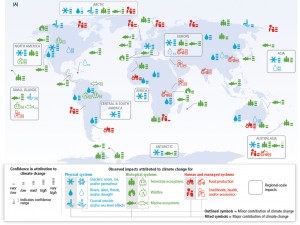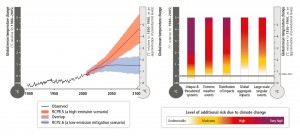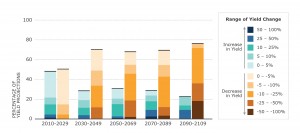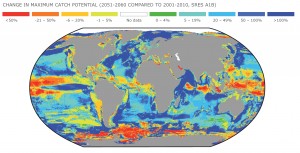The second part of the new IPCC Report has been approved – as usual after lengthy debates – by government delegations in Yokohama (Japan) and is now public. Perhaps the biggest news is this: the situation is no less serious than it was at the time of the previous report 2007. Nonetheless there is progress in many areas, such as a better understanding of observed impacts worldwide and of the specific situation of many developing countries. There is also a new assessment of “smart” options for adaptation to climate change. The report clearly shows that adaptation is an option only if efforts to mitigate greenhouse gas emissions are strengthened substantially. Without mitigation, the impacts of climate change will be devastating.
Guest post by Wolfgang Cramer
On all continents and across the oceans
Impacts of anthropogenic climatic change are observed worldwide and have been linked to observed climate using rigorous methods. Such impacts have occurred in many ecosystems on land and in the ocean, in glaciers and rivers, and they concern food production and the livelihoods of people in developing countries. Many changes occur in combination with other environmental problems (such as urbanization, air pollution, biodiversity loss), but the role of climate change for them emerges more clearly than before.
Fig. 1 Observed impacts of climate change during the period since publication of the IPCC Fourth Assessment Report 2007
During the presentation for approval of this map in Yokohama many delegates asked why there are not many more impacts on it. This is because authors only listed those cases where solid scientific analysis allowed attribution. An important implication of this is that absence of icons from the map may well be due to lacking data (such as in parts of Africa) – and certainly does not imply an absence of impacts in reality. Compared to the earlier report in 2007, a new element of these documented findings is that impacts on crop yields are now clearly identified in many regions, also in Europe. Improved irrigation and other technological advances have so far helped to avoid shrinking yields in many cases – but the increase normally expected from technological improvements is leveling off rapidly.
A future of increasing risks
More than previous IPCC reports, the new report deals with future risks. Among other things, it seeks to identify those situations where adaptation could become unfeasible and damages therefore become inevitable. A general finding is that “high” scenarios of climate change (those where global mean temperature reaches four degrees C or more above preindustrial conditions – a situation that is not at all unlikely according to part one of the report) will likely result in catastrophic impacts on most aspects of human life on the planet.
Fig. 2 Risks for various systems with high (blue) or low (red) efforts in climate change mitigation
These risks concern entire ecosystems, notably those of the Arctic and the corals of warm waters around the world (the latter being a crucial resource for fisheries in many developing countries), the global loss of biodiversity, but also the working conditions for many people in agriculture (the report offers many details from various regions). Limiting global warming to 1.5-2.0 degrees C through aggressive emission reductions would not avoid all of these damages, but the risks would be significantly lower (a similar chart has been shown in earlier reports, but the assessment of risks is now, based on the additional scientific knowledge available, more alarming than before, a point that is expressed most prominently by the deep red color in the first bar).
Food security increasingly at risk
In the short term, warming may improve agricultural yields in some cooler regions, but significant reductions are highly likely to dominate in later decades of the present century, particularly for wheat, rice and maize. The illustration is an example of the assessment of numerous studies in the scientific literature, showing that, from 2030 onwards, significant losses are to be expected. This should be seen in the context of already existing malnutrition in many regions, a growing problem also in the absence of climate change, due to growing populations, increasing economic disparities and the continuing shift of diet towards animal protein.
Fig. 3 Studies indicating increased crop yields (blue) or reduced crop yields (brown), accounting for various scenarios of climate change and technical adaptation
The situation for global fisheries is comparably bleak. While some regions, such as the North Atlantic, might allow larger catches, there is a loss of marine productivity to be expected in nearly all tropical waters, caused by warming and acidification. This affects poor countries in South-East Asia and the Pacific in particular. Many of these countries will also be affected disproportionately by the consequences of sea-level rise for coastal mega-cities.
Fig. 4 Change in maximum fish catch potential 2051-2060 compared to 2001-2010 for the climate change scenario SRES A1B
Urban areas in developing countries particularly affected
Nearly all developing countries experience significant growth in their mega-cities – but it is here that higher temperatures and limited potential for technical adaptation have the largest effect on people. Improved urban planning, focusing on the resilience of residential areas and transport systems of the poor, can deliver important contributions to adaptation. This would also have to include better preparation for the regionally rising risks from typhoons, heat waves and floods.
Conflicts in a warmer climate
It has been pointed out that no direct evidence is available to connect the occurrence of violent conflict to observed climate change. But recent research has shown that it is likely that dry and hot periods may have been contributing factors. Studies also show that the use of violence increases with high temperatures in some countries. The IPCC therefore concludes that enhanced global warming may significantly increase risks of future violent conflict.
Climate change and the economy
Studies estimate the impact of future climate change as around few percent of global income, but these numbers are considered hugely uncertain. More importantly, any economic losses will be most tangible for countries, regions and social groups already disadvantaged compared to others. It is therefore to be expected that economic impacts of climate change will push large additional numbers of people into poverty and the risk of malnutrition, due to various factors including increase in food prices.
Options for adaptation to the impacts of climate change
The report underlines that there is no globally acceptable “one-fits-all” concept for adaptation. Instead, one must seek context-specific solutions. Smart solutions can provide opportunities to enhance the quality of life and local economic development in many regions – this would then also reduce vulnerabilities to climate change. It is important that such measures account for cultural diversity and the interests of indigenous people. It also becomes increasingly clear that policies that reduce emissions of greenhouse gases (e.g., by the application of more sustainable agriculture techniques or the avoidance of deforestation) need not be in conflict with adaptation to climate change. Both can improve significantly the livelihoods of people in developing countries, as well as their resilience to climate change.
It is beyond doubt that unabated climate change will exhaust the potential for adaptation in many regions – particularly for the coastal regions in developing countries where sea-level rise and ocean acidification cause major risks.
—
The summary of the report is found here. Also the entire report with all underlying chapters is online. Further there is a nicely crafted background video.
Wolfgang Cramer is scientific director of the Institut Méditerranéen de Biodiversité et d’Ecologie marine et continentale (IMBE) in Aix-en-Provence one of the authors of the IPCC working group 2 report.
Weblink
Here is our summary of part 1 of the IPCC report.





CD, it’d be easier just to admit you’re wrong than to go on disparaging people’s work on the issue.
Yes, rough guesstimates of climate sensitivity in the past were in the same ballpark as modern work.
Still the IPCC’s work is needed — to convince you and your peers.
It’s clear you don’t like the science.
Well, history shows that legal and economic systems that rely on misunderstanding the world for short term profit don’t stand forever. Yet they’re very popular with those who build them, while they last.
Science is starting to show us _how_ and _why_ that’s been a problem — forever in human history.
We get our picture of the world wrong, and on that basis we make money fast.
That error has cost us the Earth, slowly. Shifting baselines change so slowly each generation til the last few has had no clue about that.
Well la, most of us aren’t delighted by discovering we and our predecessors were wrong and have turned a real planet into imaginary money and played games with it.
That doesn’t change how the world works.
We can understand it, if we are willing to try.
We can do great things if we take better precautions.
Climate sensitivity is still being worked out, in detail.
We know it within limits that are being improved.
As noted above by Gavin:
and the more recent topics. Yes, do the math.
Understand the work done so far. More’s to come.
Thw WGIII SPM concerning mitigation is out lacking some language that is included in the base report. The missing language concerns the need for developing countries to cut emissions and the need for developed countries to foot some of the bill for for development related mitigation efforts in undeveloped countries. http://www.nytimes.com/2014/04/14/science/earth/un-climate-panel-warns-speedier-action-is-needed-to-avert-disaster.html
WGIII SMP:http://report.mitigation2014.org/spm/ipcc_wg3_ar5_summary-for-policymakers_approved.pdf
The US is in an excellent position to cut this Gordian knot since it is cutting emissions without having committed to do so through formal negotiations: our emissions cuts are not contingent. The US can legally place tariffs on the imports from countries that are increasing emissions and devote a portion of the tariff revenue to assisting countries that are holding emissions steady at a low level owing to barriers to development in return for a pledge not to increase emissions. This would allow broader demonstration of the entirely clean development model taken up by, for example, the Maldives.
This attacks the tied problems by placing external constraint on developing nations that are increasing emissions while cultivating a very appropriate funding source for clean development assistance without channeling funding away from the developed world’s transition from fossil fuel dependence, which must not be slighted or slowed at all.
Hank (#151),
Read the links. No Pipeline. A brief jump owing to aerosols has no effect on sea level rise. I think it would be much better for you to admit that you have a trollish side, and when you call someone on units, and have made an error in doing that, you tend to persist in your rudeness.
It is fine with me if you think being off by a factor of four in 1965 is close enough for government work. But it is truly disparaging of subsequent work to claim the number was well known at that time, and well enough known to know when to stop burning fossil fuels. That was my objection to the conspiracy claim, and it was a sound one.
> brief jump owing to aerosols …
> off by a factor of four in 1965 …
> well enough known to know when to stop …
> the conspiracy claim ….
and I wrote nothing of the sort.
Who _are_ you replying to? Not to me.
This topic is getting badly derailed by this nonsense.
Argue about the IPCC’s statement, if you have reason to argue that.
And learn something from history:
http://www.aip.org/history/climate/timeline.htm
Hank (#154),
Well if you are going to jump in with an erroneous correction on units without reading the discussion, it is not too surprising that you would clueless about what the discussion is about. What I had to say was correct. You are just chasing your tail apparently.
Hopefully there will be an RC post on the WGIII report on mitigation, but in the mean time, rumors about the next mitigation steps for the US are circulating. http://washingtonexaminer.com/epa-sends-proposed-emissions-rule-for-existing-power-plants-to-white-house/article/2546607
It may be that stationary source emissions regulations will be salted with the ability to do offsets in renewable energy. Are there advantages in the short term to allowing coal plants to run when the wind is not blowing and the sun is not shining? Natural gas has staked out a claim to being the bridge fuel, but can coal claim to be a stepping stone fuel?
And, since the EPA already proposes to regulate emissions from new power plants, should not new renewable energy be regulated under those rules, not as some annex to existing polluting plants? http://www2.epa.gov/sites/production/files/2013-09/documents/20130920factsheet.pdf
Further to my (#152),
I should mention that for the US to take on the proposed leadership role of channeling climate tariff revenue to clean development assistance will involve some sacrifice (which should make curmudgeons happy). Low cost imports would no longer be as low cost. However, we might offset this with higher incomes if we notice our advantage in thin film solar manufacturing. If the aid we provide comes in the form of US manufactured clean energy goods, then we may not be bothered so much by consumer price inflation. The prior administration proposed a fairly outlandish plan to essentially form a cartel in nuclear fuel and lease it out. But, First Solar’s CdTe panels include recycling in their purchase contracts. That seems much more reasonable.
The US Export/Import Bank is facilitating some clean energy deals. http://www.exim.gov/ Perhaps that should be ramped up.
CD @ 148. You are way off topic with that post so I’ll correct you one last time.
You indeed have little sense of history, with your lack of understanding on the cumulative emission problem as well as your little rant on human rights. We in the U.S. would do well to stop lecturing others given our own sordid history with native Americans, the middle passage, etc.
If it’s not obvious to you by now that lacking any moral or factual high ground we need to make every effort to work in concert with others, then you’ll be unable to make any positive contribution to the discussion.
I’m going to take my own advice when first you resurfaced, and resume rolling my eyes at your rants.
SA (#132)
We can see further evidence of imprecision in understanding of global warming in 1965 from the claim that sea level could rise 10 feet with a warming of 3.9 C. In fact the sea level rise for 2 C warming is about that much in 2300 and still rising. http://ssi.ucsd.edu/scc/images/Schaeffer%20SLR%20at%20+1.5%20+2%20NatCC%2012.pdf
On the other hand, ending emissions after a 25% increase over the 1965 carbon dioxide concentration would halt sea level rise at around 5 feet around 2200. That would lead to an attenuated NYC, but perhaps not abandonment.
For a precautionary approach like Kyoto to work, you have to have your scientific ducks in an row. Kyoto probably occurred as early as feasible in terms of scientific certitude. With the early advent of dangerous climate change, we are no longer in a precautionary posture but in a reactive posture. At this point there are people to blame for actual damage, particularly China’s intransigence at Kyoto and the impossibility still to plan our response owing to their unwillingness to commit to any limit on emissions. We don’t know if we lose NYC in 2400 under a 2 C limit or if we lose NYC a century and a half earlier under a blown limit owing to China’s maleficence.
A shift from a precautionary to a reactive posture means new methods will be brought to bear. Unfortunately, the mutual veto on the security council between the US and China means that some UN tools that are used to bring quicker and less costly solutions to conflicts will not be available. The effort behind the Framework Convention on Climate Change is never going to have UN sanctions as an enforcement mechanism, for example.
The element of blame has entered the climate policy arena now. If it is going to be a useful tool in preventing damage, it should be applied where it will do the most good. Blaming President Nixon, as fun as it is to still kick him around, just isn’t going to help, nor is it accurate. Though you can blame him for giving Taiwan’s security council seat to the mainland if you want.
Chris Dudley #157 – Impacts of Climate Change – Part 2 of the new IPCC Report has been approved,
“I should mention that for the US to take on the proposed leadership role of channeling climate tariff revenue to clean development assistance will involve some sacrifice (which should make curmudgeons happy).”
I object to the implications of that statement. If you had a life-threatening condition, and your doctor told you the only chance for survival was an uncomfortable regimen of high-dose Key-mo, would you call him a curmudgeon? If it worked, you would probably revere him as a Saint! On the other hand, if he gave you some comfortable treeetment that did nothing for your survival, how would you (or more likely your heirs) view him? You/they would probably sue him for malpractice.
Why, then, do you take the opposite approach for climate change amelioration. Those of us who recommend the harsh and uncomfortable actions required to avoid the impending climate catastrophe are vilified, while the malpractitioners who promise ‘prosperity’ and ‘no hardships required’ are treated as credible by posters and moderators alike. Would we allow malpractitioners to publish in the credible medical journals? Why, then, do we allow the malpractitioners of climate change amelioration to post their misinformation/disinformation on the credible climate advocacy blogs?
http://www.locusmag.com/Perspectives/2014/03/cory-doctorow-cold-equations-and-moral-hazard/Walter (#158),
I agree with you that you started out with name calling and have not let up since.
DIOGENES (#160),
Sorry if you took offense. There are a lot of doomers that form a sort of unkindness around the issue of climate change. On the up side, we can grow the US economy by a factor of 2.6 while cutting greenhouse gas emissions by more than 82% from year 2000 emissions levels by 2050. http://www.rmi.org/reinventingfire
Don’t you find it rather odd that for a problem that needs to be addressed seriously within 15 years or so, we hear so much about population issues in comments? That seems to me to be curmudgeon central.
162. We’re agreed that you lack a factual basis for your rants, to the point that you don’t remember “what I started out with.”
The WG III final draft “Climate Change 2014: Mitigation of Climate Change” is now available. It’s Chapter 13 does seem to indicate that China has to cut emissions for mitigation to occur:
“Income patterns and trends as well as distribution of GHG emissions have changed significantly since the 1990s, when the UNFCCC and Kyoto Protocol listed Annex I/Annex B countries; some countries outside these lists have become wealthier and larger emitters than some countries on these lists (U.S. Department of Energy, 2012; WRI, 2012; Aldy and Stavins, 2012). For example, in 1990, China’s total CO2 emissions were about half of United States emissions, but by 2010, China emitted more than 50% more CO2 than the United States. Over this same time period, China’s per capita CO2 emissions experienced an almost three-fold increase, rising to nearly equal the level in the EU, but still about 36% of the United States level (IEA, 2012; JRC/PBL, 2012; PBL, 2012, see Annex II.9; Olivier et al., 2012). Non-Annex I countries as a group have a share in the cumulative global greenhouse emissions for the period 1850 to 2010 close to 50%, a share that is increasing (den Elzen et al., 2013b) (see Section 5.2.1 for more detail on historical emissions).”
Elsewhere it describes how China has pledged to increase emissions.
http://mitigation2014.org/report/final-draft/
“On the up side, we can grow the US economy by a factor of 2.6 while cutting greenhouse gas emissions by more than 82% from year 2000 emissions levels by 2050.”
No ‘WE’ can’t. Forget climate change. The laws of thermodynamics say you are wrong!
Growth has an expiration date and it is coming due very quickly.
http://fora.tv/2011/10/26/Growth_Has_an_Expiration_Date
Fred (#166),
For the last couple of decades we’ve had about that growth rate on average. I guess your understanding of thermodynamics is badly flawed. Give Amory Lovins a call, he can probably put you straight.
Speaking of impacts, as we have been on this thread, here is a beautiful piece of reporting on the impact of climate change in Peru. It’s very much in line with the discussion in “Six Degrees” (and elsewhere.)
Says a mountain villager:
An environmental engineer:
Peru’s Director of the Environment, Department of Foreign Affairs:
http://www.cbc.ca/edmonton/features/dying-for-a-drink/disappearing-act.html
Funny you should mention him, here’s his comment about ‘The Limits to Growth The Thirty Year Update’ perhaps you should read the book!
“Thirty years ago, The Limits to Growth was widely but erroneously attacked for prophesying doom, ignoring price, and denying adaptation. Today, its timely update remains an exceptionally valuable tool for creating the kind of future we want.”
—Amory B. Lovins, CEO, Rocky Mountain Institute
http://www.donellameadows.org/archives/a-synopsis-limits-to-growth-the-30-year-update/
Fred (#168),
I don’t think we’ve gotten any closer to clearing up your misconceptions about thermodynamics.
Fred (#168),
Possible miscommunication there. I mentioned Lovin’s because he is the source of the “we can grow the US economy by a factor of 2.6 while cutting greenhouse gas emissions by more than 82% from year 2000 emissions levels by 2050.” figures. So, it is not funny at all that I should mention him. You may also want to look at Scenario 9 from Meadows et al. which probably fits fairly well with some of Lovins’ scenarios for the US.
Chris Dudley,
“I don’t think we’ve gotten any closer to clearing up your misconceptions about thermodynamics.”
I’m pretty sure my understanding of thermodynamics is sound, thank you, as is my understanding of system dynamics and ecosystems etc. I also grasp the concept that all economic systems are subsidiaries of Ecosystems Inc. Furthermore I have had the opportunity to work both in the oil industry and more recently in the solar industry. I have also traveled the world and seen first hand some of the social strife that is being caused by peak resources, climate change and limits to growth. I am not impressed by a continued insistence in pushing the mantra of so called ‘Economic Growth’ It ain’t working! It won’t solve any of our problems. BTW since at one time you mentioned that I had better hope for economic growth, let me say that my personal hopes are completely irrelevant. However basing public policy on the notion that the tooth fairy will bail us out of our current predicament is not something that I can or will support! I guess we will just have to agree to disagree.
Fred (172),
Well if you feel your understanding of thermodynamic is adequate, perhaps you can explain what you mean. I can guarantee that you will end up making elementary errors just based on your claim.
The WG III report indicates that economic growth is not the culprit in climate change, rather it is fossil fuel use, which may be profitably substituted. So, you seem to have picked the wrong target. What you are calling limits to growth may just be averse market distortions such public subsidies for fossil fuel use. If policy leaves you stuck in a fossil fuel rut, you may perceive limits that are really just illusions.
Chris,
Here is a very good primer on ecosystem thermodynamics.
http://www.uni-kiel.de/ecology/users/fmueller/salzau2006/ea_presentations/Data/2006-07-05_-_Thermodynamics_II.pdf
Right now there is plenty of evidence that we are already in deep ecological overshoot! Yet you insist that the only way forward is to go ever deeper into ecological debt?
http://www.footprintnetwork.org/en/index.php/GFN/page/world_footprint/
“World Footprint
Do we fit on the planet?
Today humanity uses the equivalent of 1.5 planets to provide the resources we use and absorb our waste. This means it now takes the Earth one year and six months to regenerate what we use in a year.
Moderate UN scenarios suggest that if current population and consumption trends continue, by the 2030s, we will need the equivalent of two Earths to support us. And of course, we only have one.”
This is backed up by lots of very good data:
http://www.footprintnetwork.org/en/index.php/GFN/page/footprint_science_introduction/
“National Footprint Accounts measure the ecological resource use and resource capacity of nations over time. Based on approximately 6,000 data points per country per year, the Accounts calculate the Footprints of 232 countries, territories, and regions from 1961 to the present. These accounts provide the core data that is needed for all Ecological Footprint analysis worldwide.
Although these accounts provide the most comprehensive aggregate indicator of human pressure on ecosystems currently available, the National Footprint Accounts are a work in progress.”
If you have a yearly income of $100,000.00 and you’re spending $150,000.00 year after year by drawing down your savings you will at some point have to stop doing that and start living within your means.
I guess where we disagree is that I think we have already reached the point where we can no longer continue to grow our ecological footprint and you seem to believe that we still can.
Fred Magyar #174,
“If you have a yearly income of $100,000.00 and you’re spending $150,000.00 year after year by drawing down your savings you will at some point have to stop doing that and start living within your means.”
We are now at the point where we have used up our carbon savings, and are spending against our carbon creddit card.
Fred (#174),
Well, that is not thermodynamics, and that tentative Fourth Law borders on Aristotelian Final Causes which would make it spiritualism, not science. (SA, notice the word I didn’t use.)
The footprint concept can be useful if you know who you are stepping on. According to the WG II report we get 270 GtC more emissions before we start causing mass extinctions through climate change. We seem to be killing off amphibians by not washing our shoes, but that is not climate change. Different kind of footprint…. In my opinion, we are at the point where we can deeply reduce our carbon footprint and we might not even require the whole 270 GtC cushion. We can certainly dispense with photosynthesis for fuel which will lay off our land use impacts. According to some things I’ve looked at recently, we could, in principle, avoid most use of photosynthesis aside from fresh air and perhaps convenient carbon sequestration.
Now, that “Fourth Law” does have some application if there is agency such as people wanting more natural land use. I suspect a world population of 40 billion people living in harmony with vast herds of bison on the North American plains is quite feasible as a result of full exploitation of solar technologies’ efficiency advantage over photosynthesis. Odum recognized this sort of thing and your link may be a misinterpretation of his work (which crucially included selection pressure for agency).
You are concerned about overshoot, I’d say we have not even begun to arrange the furniture in a pleasant way.
Chris Dudley @ 176,
“…that tentative Fourth Law borders on Aristotelian Final Causes which would make it spiritualism, not science.”
Perhaps you should take that up directly with Dr. Huckauf. If I’m not mistaken, he holds a PhD in physical Chemistry, I’m sure he would be interested in finding out that he is a spiritualist and not really a scientist.
From his web page:
“My research interests are the chemical syntheses and the high-resolution molecular spectroscopic investigations of small molecules and weakly bound (van der Waals) complexes with a main focus on
high-resolution rotational, rovibrational and vibrational spectroscopy in the centimetre-, millimetre- and submillimetre-wave range,
unstable and/or carbon-chain containing (linear) molecules such as alkinyl (iso)cyanides which are of great astrophysical interest and
quantum chemical calculations that supplement the experimental methods.”
I’m going to go out on a limb here and make the wild assumption that he has a least a basic understanding of the laws thermodynamics.